
by David McGuffin | Aug 4, 2014 | Blog, David's Journal, Experiencing Europe
Enjoying the opportunity to sleep in!
We slept in this morning, knowing there would be plenty of time to explore Athens in the next few days. After breakfast, Charlotte and I checked out of the Electra Hotel and walked five blocks to their sister hotel, The Electra Palace. Normally, I do not change accommodations, but we are booking this trip as we go, not knowing from day-to-day what the next one holds.
The Electra Palace
 The Electra Palace has one benefit over the Electra Hotel and that is its rooftop pool with grand views of the Acropolis. We are paying premium prices for our room here, but the benefit of having an “oasis” in the heart of Athens, plus the rooftop pool makes it a worthwhile expense.
The Electra Palace has one benefit over the Electra Hotel and that is its rooftop pool with grand views of the Acropolis. We are paying premium prices for our room here, but the benefit of having an “oasis” in the heart of Athens, plus the rooftop pool makes it a worthwhile expense.
Our tour “group” grows…
Our friend, Janey, arrived in Athens earlier this morning and was waiting for us in the hotel lobby. As expected, our rooms were not ready, so we gave the hotel a “once over” and headed up to the rooftop pool and bar area. We took a seat, with the Acropolis hovering over us in the distance, and sketched out a rough plan for our adventure in Greece.
I had been to Athens on three previous occasions, the first in 1977 (which I will continue to reference here in my writings), the second in the summer of 2006, and the last in December 2010. But beyond Athens (and the island day trips to Aegina, Porous, and Hydra), it is all going to be a new adventure. Our rough planned itinerary looks likes this: Athens, Delphi, Olympia, the Mani Peninsula, Napflio, and the island of Santorini.
A lazy afternoon at the pool…
Later, we checked into our rooms and while Janey napped off her jetlag, Charlotte and I changed into our bathing suits and headed to the pool. We enjoyed a relaxed lunch, cool dips in the pool, and great views of the Acropolis. We were so close I could see weary and over-heated tourist walking on the Acropolis, frantically trying to fit their sightseeing in during the hottest part of the day.
Me and my journal…
I became faithful with my journal entries in the summer of 1997. Since then, I’ve kept a pretty good record of things happening in my life and especially my travels. Over the years, my journal has become a companion and a place to escape, especially when traveling alone with no one to talk to. I enjoy putting my thoughts to paper and sketching. This afternoon, I tried to capture the mood and feel of the Acropolis with this sketch.
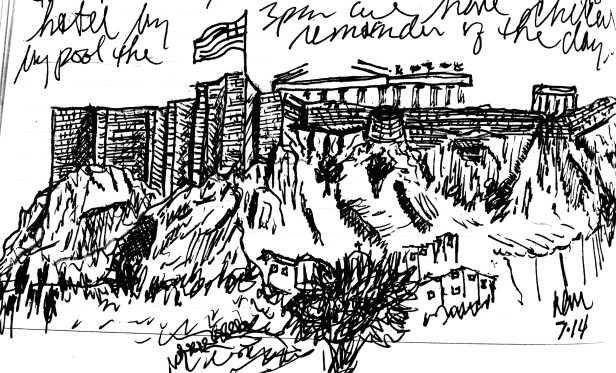
Sightseeing in the Plàka
Along about 5:30 p.m., we headed out for our sightseeing in the Plàka neighborhood. It was still hot and we stuck to the shady sides of the streets as we wound through the shopping streets, narrow lanes, past Byzantine-era churches, and the tourist oriented shops.
Ermou Street
Ermou is the main street leading from Sytagma Square into the Plàka. It once was filled with filth, loud traffic, and ugly signs. Since 2000, it has become a pedestrian-only area and both tourists and locals enjoys a stroll in this shopping oriented street.

Ermou Street
The Church of Kapnikarea
Athens was once a part of the vast Byzantine Empire which controlled much of Europe from A.D. 323-1453. This church, the Church of Kapnikarea, is a classic example of an 11th century Byzantine house of worship. Notice the classic Byzantine architectural designs including a red-tiled domed cupola topped with a cross and narrow and tall arched windows often with diamond-shaped trim.
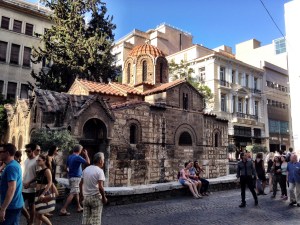
The Church of Kapnikarea
Athen’s Cathedral
This church was built in 1842 and looks much worst for wear than other churches in the area dating from 600 years before! However, it is Athen’s most important Greek Orthodox church and the “head” church of the Greek Orthodox faith. It is in dismal condition! The interior and exterior are covered with scaffolding and shrouded in construction cloth. The placard outside does list a schedule of worship services… but ughh… I can’t imaging it here.

Athens Cathedral
Adrianou Street
This IS souvenir street! Adrianou Street runs from near the new Acropolis Museum, heads north, and then turns west to follow the lays of the Acropolis hill. For me, it is the “main drag” offering all the “Greek” trinkets and souvenirs. You’ll find it all… olive oils, olive wood, worry beads, jewelry, leather sandals, sponges, Pandora beads, Greek replica statues, t-shirts, and tons of stray cats!
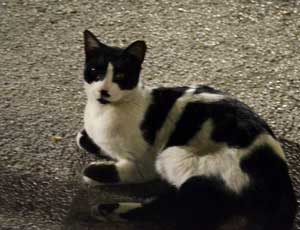
Hello kitty
The Roman Forum and Tower of the Winds
The Romans conquered Greek about 150 B.C. and set up their own “Roman”-ized way of life. The Greek Agora (I’ll address that later) became a marble “boneyard” from which the “Roman” Athens was built. Now-a-days, this area is often called the Roman Agora, but the Roman’s called it the Forum. Like in Rome, it was the commercial center of the city. A place to shop, meet, see and be seen.
Much later, the Ottomans converted this area into a bazaar. There is a mosque here in the area, although its minarets were decapitated by the Greeks when they won their independence from the Ottomans in the 1800’s.

Roman Forum & Tower of the Winds
Notice also the eight-sided domed tower known as the “Tower of the Winds.” This tower was built in the 1st century B.C. and contains a clock, a guide to the planets, and a weathervane. The carved figures depict the “winds” as winged humans who fly in and bring the weather. Don’t bother asking anyone about the meaning of the eight ancient Greek symbols for the “winds.” I’ve found everyone makes up their own story… even the guides!
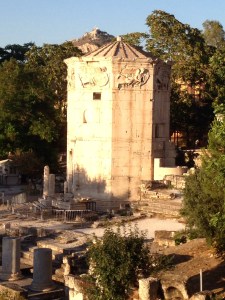
Tower of the Four Winds
Library of Hadrian
Hadrian was the Roman emperor in the 2nd century A.D. who had quite an affection for all things Greek. He had this library and civic center constructed for the Athenians. The building housed gardens, lecture halls, art galleries, and a library. Today, most of what you see is a reconstruction of one wall and a few Corinthian columns.

Library of Hadrian
Monastiraki Square
This is Athen’s second main city square loaded with old world class and style. The big building on the left is the metro station where tw0 train lines connect. From this square one could walk to the Archaeological Museum (1 mile to Omonia Square), feast on souvlaki (the typical Greek meat-on-a-stick fast food), wander into the old town, or or hop on the metro to zip off to far flung areas of town.

Monastiraki Square
By 7 p.m. we had experienced and seen the most important ancient and tourist sights in the Pàlka. Arriving at Monastriki Square and the Metro station, we decided to give the Ancient Agora a go. Following the Metro tracks, we soon came to the main Agora entrance and ticket booth.
Here’s a hint
Avoid long lines at archeological site ticket booths by arriving late in the afternoon. Alternatively, visit a lesser-known site entrance before the Acropolis. Purchase a €12 “strip ticket” for all the archeological sites in Athens including the Acropolis, Agora, Roman Forum, Keremikos Cemetery, Library of Hadrian, Theatre of Dionysus, and the Temple of Olympian Zeus. The ticket is valid for four days, and technically the attendant will tear off one “strip” for each site you visit. However, I did not have any collected except at the Acropolis. IF you purchase your ticket first at the Acropolis, then you’ll receive one ticket with a bar code that will be scanned at each site visited.

The Ancient Agora
Visiting the Ancient Agora during its final hour of the day was a good idea. Although the sun was still high and warm, there were only a few tourists milling around. We were able to see almost all the Agora sites in less than an hour, although it was a push to get up to the Temple of Hephaistos before the attendants began blowing their whistles to alert of the impending closing time of 8:00 p.m.
Temple of Hephaistos
This is one of the most well preserved of all Greek temples. Construction began here in 450 B.C. shortly after the entire Agora was destroyed by the invading Persians (480 B.C.). However, construction work stopped here while the Athenians concentrated on building the temples on the Acropolis, including the Parthenon. The temple is dedicated to Hephaistos, the “blacksmith” god and originally contained bronze statues of he and Athena.

Temple of Hephaistos
The temple was converted to a Christian church in 1300 A.D. and named the Church of St. George (the patron saint of Athens). Because of its continued use, the structure was maintained and kept up resulting in the wonderful condition in which we find it today.
The Agora in 1977
My notes, dated May 5, 1977, mention visiting the Temple of Hephaistos…
I got up at 6:15 am yesterday morning and walked down to the Temple of Zeus and took photos, then went to the Olympic Stadium and Royal Gardens. Doug and I then went and ate breakfast at the hotel. Then took an excursion to the ancient agora and the Theseion/Temple of Hephaistos and agora museum.
Here is the photo my friend Doug snapped of me standing in the temple. I recall back then we were allowed inside the temple and could actually see the ancient frieze in the alcoves depicting mythological battles between the Lapith tribe and a group of centaurs during a wedding feast.

Temple of Hephaistos 1977
Here is a photo Charlotte snapped of me in December 2010 during our visit to Athens. The temple has remained the same, I’ve not! Notice too that I was not allowed on the steps as the entire temple is fenced off.

Temple of Hephaistos 2010
Take the back gate for a speedy exit
We exited the Agora at the “back gate” up the hill in the direction of the Acropolis (Polygnotou “street” on your map). This put us up near the top (Prytaniou street) with great views of the Plàka and Athens to the north and the Acropolis looming just overhead to the south. We experienced a fantastic sunset and later, an almost full moon rising in the west.

Sunset over the Roman Forum
The Plàka is not flat.
It stretches consistently uphill until the slops of the Acropolis makes it impossible to build houses. Consequently, the “streets” are often no more than small cobbled pedestrian paths winding past shops, restaurants, and businesses. The farther uphill one wanders, the more steps and stairs are encountered.
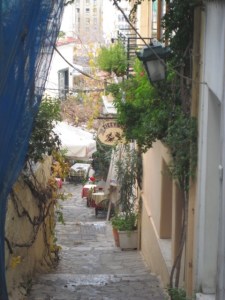
Steps and more steps
One such place, called Mnisikleous, is known for a series of cobbled stairs stretching of 100 yards and lined with trendy restaurants offering good food, decent drinks, ok music, and plenty of ambience.
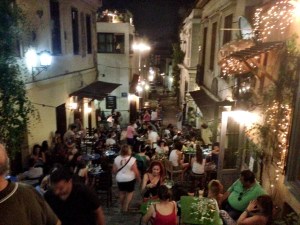
Mnisikleous Street dining
Capping off our day, we chose an outdoor restaurant known for authentic Greek food offered at very reasonable prices. Xenious Zeus is not a secret among tourist in Athens. This restaurant appears in all the guidebooks and is advertised as a place with good food and good prices. Since we were all the way up the hill, I thought we should give it a try.

.
For €12 we got a three-course meal featuring a selection of five Greek appetizers, called mezedes, a main course, and desert. We added a Greek Salad to share between the three of us. For a quick and unpretentious introduction to Greek cuisine, this place can’t be beat.

mezedes sampler
After dinner, we walked back to our hotel with a full moon rising in the west, our bellies full, and our bodies worn out. For me, this was the perfect mix of recovery, sightseeing, and dining to begin our adventures in Greece.
Read my previous post. Read my next post.

by David McGuffin | Jul 25, 2014 | Destinations
Christmas Markets in Europe
Christmas Markets spice up the winter holiday season with an extra dose of spirit and cheer. Outdoor markets celebrating Advent and the Christ child pop up in many towns from the first weekend in December right up until Christmas Eve. In German speaking regions they are known as Christkindl Markt or Weihnachtsmarkt. Our English translation is “Christ Child Market” and “Christmas Market.” However, they are not limited solely to Germany and Austria… Christmas Markets are a longtime tradition in many areas associated with the spread of Christianity in Europe under the guidance of the medieval church and the Holy Roman Empire.
My first experience at a Christmas Market
I fell in love with the “Christmas Market experience” several years ago when Charlotte and I visited Vienna and Prague. We had some airline miles to use before the end of the year, so we took off for a winter escape from the Florida heat. My luggage (and heavy winter coat) had been “lost” in flight, so my first experience was walking around Vienna’s markets in nothing but a thin cotton blazer. I assure you I had my fair share of glüwein trying to keep warm that night! I was impressed with the focus on Christmas and Christ, the hand-made unique crafts, and the general festive atmosphere.
Later, we visited Prague and experienced some of the most amazing foods. Locals were roasting huge hams on spits over open wood fires. All you had to do was walk up and they would whack off a piece, slap it on a slice of crusty bread and hand it to you. Many towns specialize in their own variety of sausages, sweets, breads, and chocolate covered treats. I can promise you’ll not go hungry! There is a fair amount of drinking too. Countless local varieties of glüwein (a piping hot mulled wine), pünsch, kinderpüncsh, schnapps, hot chocolate, and coffee are available and served in their own souvenir cup representing the Christmas Market and year.
All this, combined with chilly weather, caroling choirs, brass bands, millions of lights, and festive decorations are sure to supercharge your holiday travel experience. It is totally different traveling in the winter and being immersed in the Christmas cheer. Even if you’ve visited these destinations before in the spring or summer… this winter Christmas Market experience is like making it all fresh and new again.
Why not join us?
This year, why don’t you join me in experiencing the Christmas Markets of Germany and Austria? I guarantee you’ll catch the Christmas spirit, get in some fine shopping, eat well, experience the sights, and still be home in time to celebrate Christmas with your usual traditions.
We leave the USA on December 6 and return December 14. A few seats are still available and we are keeping one warm for you!
Merry Christmas,

See the tour itinerary, get more details, and sign-up.
Watch a video slideshow featuring all my Christmas Market destinations.

by David McGuffin | Jul 22, 2014 | David's Journal, Destinations
Leaving Ireland
I’ve been in Ireland for more than a month and although I love the Emerald Isle, I’m ready for a change. This morning, I was up at 4:30 and on my flight to Athens by 7:30. Even before my Aer Lingus flight took off, I was dozing.
Four hours and two time zones later we touched down in Athens to a totally different landscape than I’d left in Ireland. Gone were the 40 Shades of Green and patchwork quilted countryside. Now all I could glimpse out the small oval window were rocky mountains littered with scraggly shrubs, an occasional olive grove, and sun-burnt tumbleweeds.
Touchdown in Athens!
 The unmistakable grinding of the landing gear being hoisted into position alerts me our landing is near. Looking out the window, I see we are flying into a valley with mountain peaks soaring above us. I know there is a runway somewhere up ahead, but I always wonder! The young Asian kids in the seat in front of me begin exclaiming, “IKEA, IKEA, IKEA”. I look out the window, and sure enough my first recognizable landmark in Greece is the big blue and yellow marquee of the do-it-your-self megastore.
The unmistakable grinding of the landing gear being hoisted into position alerts me our landing is near. Looking out the window, I see we are flying into a valley with mountain peaks soaring above us. I know there is a runway somewhere up ahead, but I always wonder! The young Asian kids in the seat in front of me begin exclaiming, “IKEA, IKEA, IKEA”. I look out the window, and sure enough my first recognizable landmark in Greece is the big blue and yellow marquee of the do-it-your-self megastore.
Touchdown! Brakes! More brakes! Then a swift left turn and we are heading to our parking spot. No gate and gangplank for Aer Lingus! We park on the tarmac (Why do they call it that? There is no tar, it’s all concrete.) Rolling stairs are positioned at the front and rear doors, and off we go, heading to the terminal on foot.
Charlotte is meeting me here later today, so I’ve got four hours to waste in the airport until her KLM/SkyTeam flight arrives from Amsterdam. Knowing that I will eventually have groups arriving here for my Exploring Europe tours, I locate the toilets, ATM’s, money exchange, rental cars, public transportation, taxis, restaurants, and other typical airport facilities. Finally, I track down the EU and International arrivals portals (only two possibilities, areas A and B) and then get some lunch at a café.
I notice straightaway the prices are significantly cheaper here than in Ireland and the rest of Europe. My lunch cost about €15 for three courses including my drink. Yesterday in Ireland, I spent €25 plus drinks for my group’s final dinner in the seaside town of Howth.

Athens – The Parthenon
Charlotte’s flight is on time and arrives by 4:45. We connected within minutes and are in a taxi heading towards central Athens in no time. We’ve planned to stay here for three nights to tour Athens and adjust to Greece. I’ve chosen the Electra hotel group for our stay in the city. For me it is a proven hotel property that is centrally located in a safe and historic area of town. Upon arrival at the Electra Hotel, the reception agent tells us we have the “best room in the house”, gives us our key and we head up to our room.
The room is well… roomy and well appointed. Minutes after our arrival a gentleman shows up with a bowl of fruit and chilled bottled water… that’s a nice touch! We pulled the drapes and slept soundly for several hours. When we woke up, it was dark outside… about 9:30 p.m.
Flashback to 1977
This was my fourth trip to Athens’ Plaka neighborhood. The first had been in 1977 when I arrived with a group of 50 or so friends embarking on a three-week choir tour. I remember waking up that first morning in the Palka to the sounds of the street. All European cities have the same routine and associated sounds… if you are up early enough. Looking down from my balcony, I found shopkeepers washing the sidewalks with buckets of water and old scraggly brooms chatting with one another in a language foreign to me. Old men sitting at the café down the street with their first cup of coffee of the day. Dogs were wearily wandering around trying to find a morsel left from last night’s dinner, and kittens were running to and fro engaged in a skillful game of hide and seek. I’ve always remembered that first morning in Europe and given the chance, try to allow it to “evolve” naturally where ever I visit.
 Let’s Eat!
Let’s Eat!
Ok, back to present day… I asked at the hotel desk for a place to get dinner. The lady at reception quizzed me on what type of place we were looking for… fancy, four-star, typical Greek, local, or humble family-owned place. You probably know my answer,
And her directions went something like this, “out the door go left, at the corner-left, then straight, straight, straight (imagine hand motions), then right and straight, straight, straight, at the theatre turn left to the place.”
We ended up on a small square in the heart of the Plaka neighborhood surrounded by local restaurants spilling out onto the sidewalk. It was kind of funny that the lady had directed us to a place named simply “Trattoria”, a term associated with Italy, certainly not Greece. I think Charlotte and I both ordered a Greek Salad (the first of many), shrimp saganaki, and traditional chicken souvlaki with roasted potatoes.

Shrimp Saganiki
Walking back to the hotel we noticed an almost full moon rising above a nearby church. Here is Charlotte’s photo:

Back in the room and after an long day for both of us, we turn the A/C down to 18°C, pulled the drapes, and sleep soundly all night.
Read my previous post in this series. Read my next post in this series.

 Book your seat on any 2015 David McGuffin tour, and automatically save $100 per person. We are offering more tours than ever. Booking early is a sure way to lock in current prices, your preferred departure date, and save $100! Hurry, this offer ends January 5, 2015. Browse all my 2015 tours… Your Adventure Starts Here!
Book your seat on any 2015 David McGuffin tour, and automatically save $100 per person. We are offering more tours than ever. Booking early is a sure way to lock in current prices, your preferred departure date, and save $100! Hurry, this offer ends January 5, 2015. Browse all my 2015 tours… Your Adventure Starts Here!





























